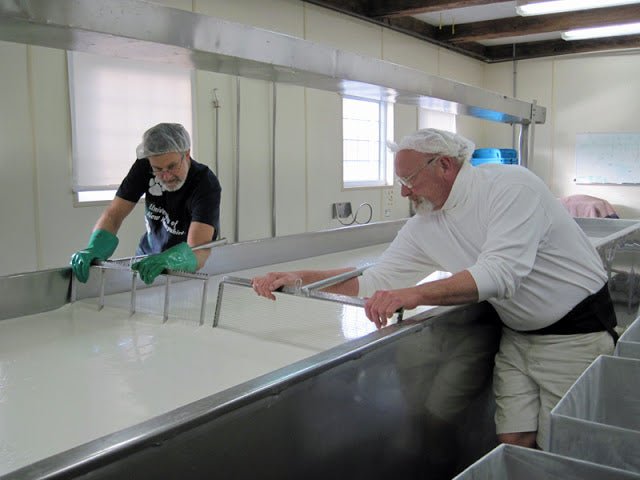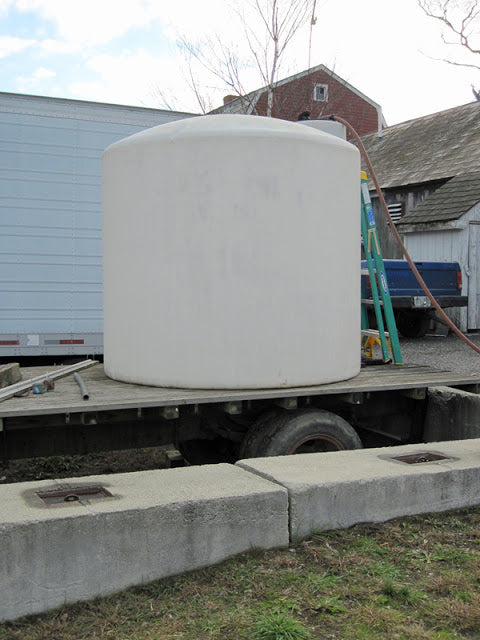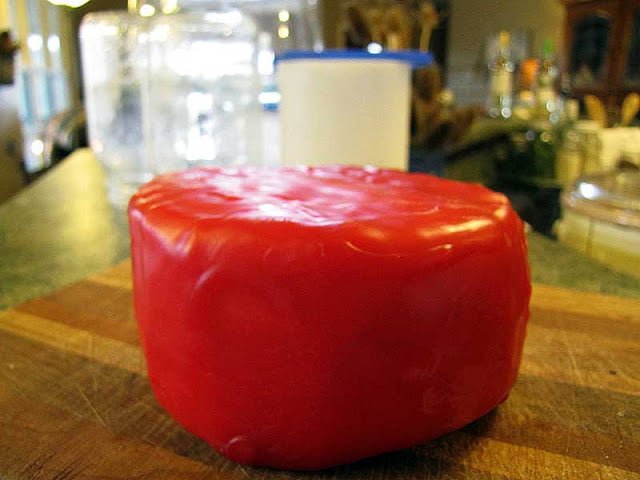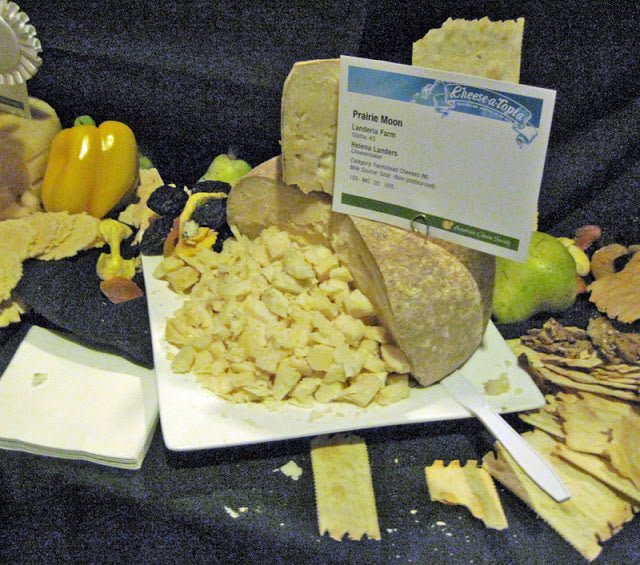Making Farmstead Baby Swiss, Fiddlehead Tommes and Jacks
Stan Richmond sat behind a desk for most of his working life. But when he was 53, five years ago, he made a big change. He came to Boggy Meadow Farm to be a cheesemaker and he hasn’t taken a seat since then.
As most of you know, making cheese commercially is hard, physically demanding work. Stan is the only full-time cheesemaker, so he does everything there is to do, from raking the curds to carrying the cheeses into the aging rooms to wrapping and shipping the final products. But, Stan grew up on a farm and he loves the work.
 |
| Paul Besaw raking the curds |
He has two part-time helpers, Joe Sawyer and Paul Besaw. Paul is Stan’s uncle. He was enjoying his retirement from a career as a carpet installer (that’s a tough job, too!) when Stan called him into service at the farm. How can you refuse your nephew?
 |
| Joe Sawyer |
Joe grew up down the road from the farm. He took the short course at UVM and completed it in record time (130 hours during his 2 week vacation from his job!) Now, he works at Boggy Meadow one or two days a week, he works for Fed Ex full-time, and he works at Vermont Shepherd part-time making sheep cheese.
In addition to that, he is now leasing space from Vermont Shepherd to make his own Tomme cheese in the Pyrenees style (we’ll have more about that when he begins selling it in March, 2011) AND he makes cheese at home!
Joe first learned how to make cheese with our book, Home Cheese Making. When he makes it at home, he uses 4 gallons of milk at a time and he ages his cheese in an old refrigerator. He sprays the inside with water to keep the humidity up. In the summer he’s too busy, but this time of year, he makes cheese (Gouda, Blue, etc.) twice a week.
Boggy Meadow Farm is located on the New Hampshire side of the Connecticut River in one of the most beautiful areas of southern New Hampshire. It’s a large farm with 1000 cows (mostly Holsteins) and 300 of them are milkers. It has been owned by generations of the same family since 1822.
When Stan came to the farm five years ago, he apprenticed with the previous cheesemakers. They were already making Baby Swiss, natural rind Tommes, and a few Jacks. Stan added many flavors of Jacks to their repertoire, including pepper, sage, dill, garlic and parsley. He also added fiddleheads to the Tommes (available online). The Jacks are sold at their farm store and at local stores, but they don’t make enough of them to sell online. Their main product is their Baby Swiss for which they won first place at the Eastern States Exposition last year.
Making the Cheese
Boggy Meadow has a very unique way of making their cheeses. As you can see in the pictures below, their vat is huge- it holds 10,537 lbs of milk. (In the end, this yields only 950 lbs. of cheese.) From this one vat of milk, they make three different cheeses together. The differences in the cheeses come from the aging process alone.
They make cheese (from fresh, raw milk) 26 times/year, mostly on Sundays, because this is the only day they can all get together. From this one vat, they make three kinds of cheeses- Swiss, Tommes and Jacks at the same time.
They do everything by hand because the automatic features of the tank stopped working five years ago. In the picture below, Stan goes down one side with the horizontal cutter while Joe works the other side with the vertical cutter. Then they change places.
There’s a little bit of finishing off to do at the end where they started.
While Stan and Joe cut the cheese, Paul cleans off the cutters and gets ready for the next step. (Behind him there’s an observation window so folks can watch everything from the farm store.)
After the cut curds heal for 5 minutes, Paul and Joe rake them for 40 minutes. This is basically “back breaking” work, but they make it look easy.
The cheeses that are pressed in the molds below get cut into 2 lb. blocks.
The presses are run off a compressor.
You might wonder about the Propionic bacteria that is added to Swiss cheese to make it form “eyes.” It was added with the culture and it is there in all three cheeses, but because they are aged at different temperatures and humidity, it only affects (makes eyes) in the Swiss. This is a technique Stan thinks the original cheesemakers at the farm learned in the Alps.
The Tommes have natural rinds, so they are aged at 50F.
They need to be brushed frequently.
The Baby Swiss are cryovaced and aged for 60 days at 70F. The Jacks are aged in a refrigerated trailer at 38F.
Selling The Cheese
You may purchase Boggy Meadow Farm cheese at their website- www.boggymeadowfarm.com. At their store they offer free samples of their cheeses and a few other local products. (While you are there, don’t forget to check out the observation window.) You may also find their Baby Swiss and Tommes at stores throughout the New England area.














































































































































































